Physical Address
304 North Cardinal St.
Dorchester Center, MA 02124
World Health Organizatin (WHO) Grade I encapsulated nerve sheath tumor composed of differentiated Schwann cells; associated with neurofibromatosis type 2 or schwannomatosis
8% to 10% of all intracranial tumors
Age range: 10 to 90 years of age with peak incidence in fourth to sixth decades
Most are solitary and sporadic
4% are associated with neurofibromatosis type 2 or schwannomatosis
Account for 29% of spinal tumors; typically arise from a nerve root
No gender predilection
Account for 85% of cerebellopontine angle tumors: most arise from vestibular branch of CN VIII; referred to as “acoustic neuroma” in this location
May occasionally arise from cranial nerves (CNs V, VII, and rarely others)
Intraspinal schwannomas most typically arise from sensory nerve roots
Rare intracerebral and intramedullary spinal cord reported
Surgical resection for large tumors; radiosurgery may be appropriate for small tumors (<2.5 cm)
Rarely if ever undergo malignant transformation
Circumscribed, sometimes cystic, enhancing mass on MRI
Extension into internal auditory canal is classic for CN VIII schwannomas
Spinal tumors are extramedullary, intradural, and occasionally extend to epidural space (“dumbbell” shape)
Well-circumscribed occasionally cystic masses ranging from a few centimeters to 10 cm
Heterogeneous cut surface with yellow or hemorrhagic foci
Most are encapsulated grossly and by histology
Tumor entirely composed of differentiated Schwann cells forming two architectural patterns:
Antoni A: closely apposed spindled tumor cells with palisading, elongated nuclei
Antoni B: less cellular areas of loosely arranged tumor cells with indistinct processes and background microcystic change
Verocay bodies are alternating parallel rows of nuclear palisades with areas devoid of nuclei occurring within Antoni A histology
Ancient change in schwannomas: bizarre-appearing nuclei sometimes having nuclear inclusions
Nuclear pleomorphism or an occasional mitotic figure is not an indications of malignancy
May have macrophages containing lipid
Thick-walled vessels with hyalinization and perivascular hemosiderin
Larger schwannomas may undergo degenerative necrosis and hemorrhage
Three major variants of schwannoma:
Cellular schwannoma: hypercellular fascicular growth pattern composed mainly of Antoni A histology (Verocay bodies absent) favor paravertebral sites and cranial nerves; low mitotic activity (<4/10 HPF)
Plexiform schwannoma: majority involve skin or subcutaneous tissues of extremities; arise in association with “schwannomatosis” syndromes
Psammomatous/melanotic schwannoma: 50% associated with Carney complex (spotty skin pigmentation, myxomas, and endocrine overactivity); 10% undergo a malignant transformation
Strongly immunoreactive for S-100
Express Leu-7 and calretinin
Focal expression of GFAP
Consistently express collagen IV and lamin in basement membrane with the exception of melanotic variant
Electron microscopy: thin, interdigitating cell processes, basal lamina, long-spacing collagen (“Luse bodies”)
Neurofibromatosis type 2: bilateral vestibular schwannomas involving CN VIII are pathognomonic
NF2 gene (chromosome 22q) is a tumor suppressor also implicated in sporadic tumors
Inactivating frameshift mutations resulting in truncation of NF2 protein product, merlin, found in 60% of schwannomas
Schwannomatosis syndrome: multiple painful schwannomas in a segmental distribution in absence of other NF2 features
Psammomatous/melanotic schwannomas associated with Carney complex:
Autosomal dominant disorder characterized by lentiginous facial pigmentation, cardiac myxoma, and endocrine disorders
Caused by mutation of PRKAR1A gene on chromosome 17q
Cerebellopontine angle tumors: meningioma, epidermoid cyst, ependymoma
Spine: meningioma, myxopapillary ependymoma
Skin: neurofibroma
Large nerve root: malignant peripheral nerve sheath tumor
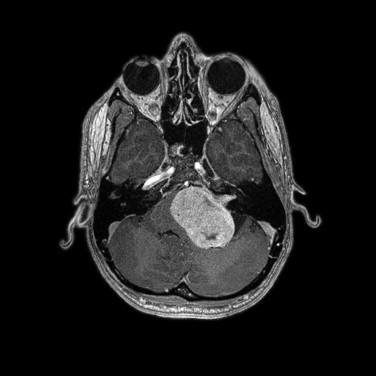
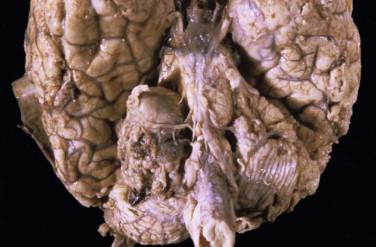
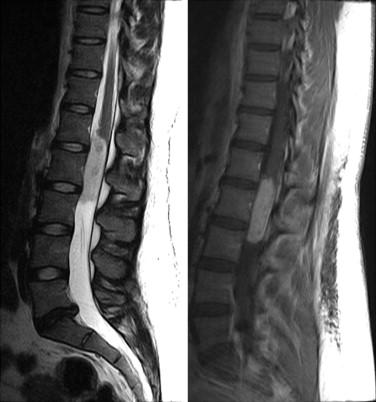
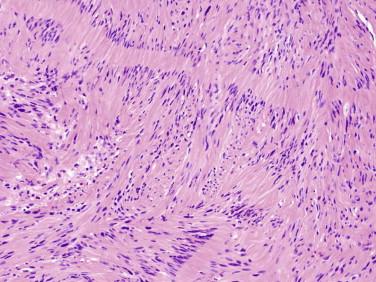
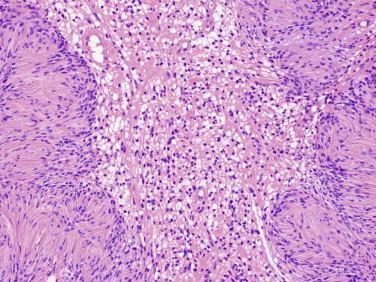
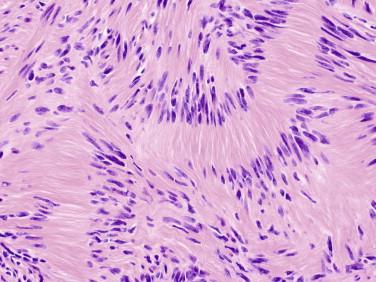
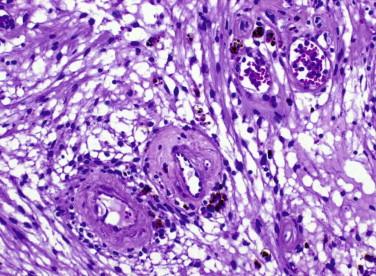
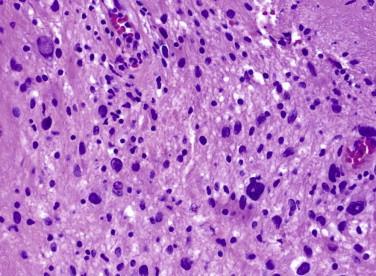
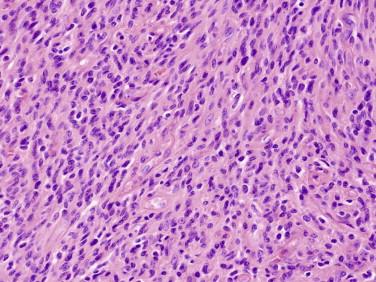
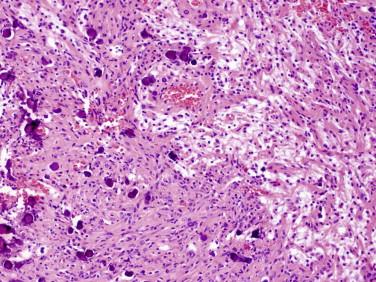
Peripheral nerve sheath tumor (WHO Grade I) composed of differentiated Schwann cells, perineurial-like cells, fibroblasts, and nerve fibers; multiple and plexiform neurofibromas are associated with neurofibromatosis type 1 (NF1)
Become a Clinical Tree membership for Full access and enjoy Unlimited articles
If you are a member. Log in here